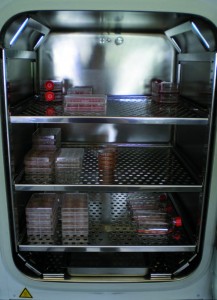WEDNESDAY, 15 MAY 2013
The UK is very proud of its large biomedical research sector, but there is a darker side to this innovative part of the economy: the amount of waste. Whether we look at the physical rubbish produced or the amount of energy used, a laboratory’s carbon footprint far exceeds that of a normal office space, shopping centre or school. The high level of safety measures required by a lab makes it unpopular with the energy-efficiency community, but it doesn’t mean that nothing can or should be done.The majority of the rubbish may not be contaminated with anything dangerous, but it is still most likely to end up in a landfill, not recycling. Most of a lab’s bin contents have been classified as bio-hazardous and therefore as posing a threat to human health or the environment—not an enticing starting point for recycling.
Anyone involved in biomedical research will tell you how keeping things sterile is extremely important. This requirement, together with ever- growing health and safety measures, dramatically increases the amount of waste produced by a lab, although laziness has its part to play as well. It is simply much less effort to open a fresh bag of sterile, single-use plastic lab implements than to go through the complicated process of sterilising their more sturdy equivalents. A few decades ago, bacteria were grown on glass petri dishes, which had to be washed and sterilised by baking at a very high temperature. Alternatively, you can sterilise your instruments by immersing them in highly concentrated ethanol and burning it off with a flame but that is not only time-consuming, it is also a fire hazard. In fact, well-meaning scientists, who are horrified with the amount of plastic waste that they produce, have very few options to improve the situation without jeopardising their experiments by potential contamination. As a result, instead of reusing anything, biologists nowadays simply reach for another plastic pre-made unit.
Like in the fruit and veg section of a supermarket, everything is packaged and wrapped in plastic. Precious and delicate reagents are delivered with ice packs, dry ice, polystyrene chips and in general so much packaging that it is often difficult to spot your item in the enormous box. However, this excess is being curbed, if not by environmentally friendly policies then by the financial crisis. New England BioLabs now ask for their polystyrene boxes and ice packs to be sent back to them so that they can be re-used for other orders. Boxes are getting smaller as profit margins fall.
The Improving Engineering Education Project of the Cambridge-MIT Institute has published a report on recycling that highlights some major problems. It’s time-consuming and therefore expensive to collect and separate different types of rubbish. The end product, for example pellets made from plastic bottles, is of lower quality than ‘virgin’ plastic made from petroleum and so has fewer applications and lower market value.
A lot has been done to make recycling easier and more popular in Cambridge. Gone are the days of 27 different material-specific bins that were far away or always full. Cambridge City Council has introduced one blue bin for recycling almost all household waste, which makes life a lot easier. Businesses are encouraged to recycle by financial incentives and the public opinion is slowly moving towards stigmatising wastefulness and applauding anything labelled ‘green’. Even the University of Cambridge has recognised the importance of doing something to help the environment. The University website proudly displays a graph, which shows small but steady growth of recycling of its waste (http:// www.admin.cam.ac.uk/offices/em/sustainability/ environment/guidance/waste.html). It does not comment on the rise in the amount of rubbish going to landfill in most recent years. University Policy on Environmental Issues states that: “The University will (...) make continued efforts to reduce its environmental impact through the implementation of an Environmental Plan, which sets out a range of objectives and targets related to its significant environmental impacts, including (...) to minimise waste and pollution, and to operate effective waste management procedures.”
One of the goals set out by the Environmental Plan is to “enhance the reputation of the University”, as well as reduce the costs of waste disposal. To this effect, the blue recycling bins have been introduced to the Cambridge Institute of Medical Research. A bold move for the University, but it also caused a bit of confusion. Most people at the Institute agree recycling is good and desirable, but what to recycle in a lab? The helpful brochure suggests telephone books and cans, but doesn’t mention gloves and tubes. Even when they are not biohazardous waste they sure look that way and in the end were banned from the recycling bins. So much for recycling in the lab.
However, physical waste is only the tip of the iceberg. The amount of energy a typical lab uses is staggering, mainly because of the many pieces of equipment, which use a lot of electricity and are always on. It’s not just the constantly running computers or office lights, but the huge energetic cost of running CO2 incubators at a specific temperature, fridges and freezers, pumps, ovens, water baths and heat blocks, some of which are left on mostly for convenience. But as the energy costs are rising and being environmentally friendly becomes not only fashionable but a legal obligation, new policies might be cracking down on this excessive usage. According to the Vice-Chancellor, Sir Leszek Borysiewicz, the University’s target is to reduce its energy-related carbon emission by 34 per cent by 2020 as compared to 2005. A new initiative called ‘Switch-Off week’ ran in February across the University’s departments and colleges in an attempt to raise awareness amongst both the staff and the students of how much energy is being wasted. Using a dedicated website (http://www.admin.cam. ac.uk/carbon/getting_involved/sow.html) one could check the daily reports showing how much energy had been saved in total and by each department. It was also translated into how many miles a cyclist could travel on that amount of energy. An example of a more long-term solution would be introducing volunteer ‘switch-off marshals’, who make rounds in the evening trying to limit the amount of electricity wasted.
Ironically, the biggest help in the crusade for more ‘green’ lab space is the financial crisis and the funding cuts associated with it. When a smaller budget has to last longer, every money- saving measure counts. This can start with more energy efficient equipment, more re-usable or recyclable consumables and can go all the way to improving whole building designs. A good example is the Lawrence Berkeley National Laboratory in California, which set out to find more efficient solutions in the building design in order to achieve a U.S. Green Buildings Council LEED Silver rating. Thanks to a very efficient ventilation system and an energy-efficient boiler and chiller plant, they managed to surpass expectations and were awarded the LEED Gold rating. As one of the engineers involved in the project implied, reducing the carbon footprint of a lab is challenging and sometimes quite difficult, but with the right attitude and new technologies it is entirely possible.
Maja Choma is a 4th year PhD student at the Cambridge Institute for Medical Research




